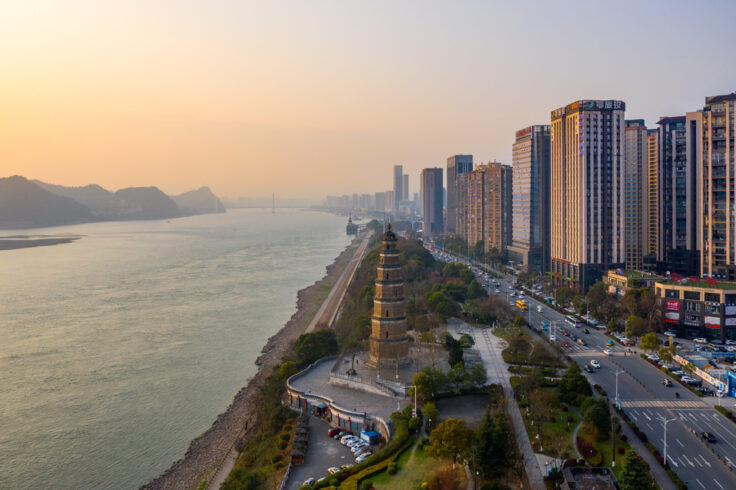May 07, 2024
Towards A Low-Carbon Future for Yichang, China
A version of this article was originally published in the No. 35 issue of the Sustainable Transport Magazine. Read it here.
By Han Deng and Qiuyang Lu, ITDP China
During the 2020 United Nations General Assembly, China announced its goal of achieving carbon neutrality before 2060. Although this timeline is further out than the 2050 goals set by nations like the United States, it is nonetheless an ambitious target given China’s extensive emissions footprint, diverse economy, and significant population. To tackle this major challenge, ITDP has spearheaded efforts with regional and global partners to guide Chinese cities towards transport emissions reductions. One promising example of these efforts is in Yichang, a city with a population of over four million nestled in a cluster of cities in central China’s Hubei province.
Since 2022, ITDP has been supporting the World Bank in assessing Yichang’s emissions profile and evaluating the feasibility and cost-effectiveness of various decarbonization policies applied in the context of the city, particularly as it relates to urban transport. This work addresses an important and timely question for the region: how can cities in China develop actionable transport strategies to benefit people and the climate?

Yichang’s Emissions Profile
China continues to be one of the world’s top three greenhouse gas (GHG) producers, and its transport sector is the fourth largest contributor to this. Reducing transport-related emissions is a pressing priority for China’s government. With more than 65% of the population living in urban areas, focusing on low-carbon transitions in mid- and large-sized cities is crucial for future change.
In the assessments conducted by ITDP and partners, it was revealed that Yichang’s primary emissions source is, in fact, road transport and it accounted for upwards of 80% of the city’s emissions between 2015 and 2021. Private passenger vehicles were the most significant contributor to total emissions, with freight transport coming in second. In addition, given Yichang’s strategic location along the Yangtze River, water-based cargo transport contributes nearly 10% of the city’s transport emissions, with railways and civil aviation contributing another 10% together.

Cars and Freight Driving High Emissions
Yichang’s car ownership rates have risen an astounding 96% since 2015, with an estimated 640,000 car owners as of 2020. The COVID-19 pandemic also reduced public transport ridership dramatically in China, pushing more people to opt for private vehicles. This shift toward cars, rather than public transport or active mobility, has contributed significantly to the city’s rising emissions in recent years. Yichang’s efforts to evaluate and understand its emissions profile are essential to identifying potential areas for more sustainable mobility interventions and progress.
The popularity of e-commerce and goods delivery in recent years has also led to a rapid rise in Yichang’s road cargo and freight challenges. In 2019, emissions from freight in the city accounted for 81% of total emissions from all road transport. For the city to successfully address emissions, freight and cargo delivery logistics systems must be better optimized to promote more rail- and water-based deliveries rather than fuel-based vehicles. Expanding the proportion of electric and clean energy vehicles is just as crucial to limiting the GHG impacts of the delivery sector.
Optimizing travel demand is another solution for tackling emissions. Rapid urbanization has dramatically changed the city’s planning, exacerbating long commute times and congestion. New development models should help reduce the demand for unnecessary travel through compact urban planning that streamlines access to essential services and destinations while highlighting walking, cycling, and public transport. With the pandemic-driven rise in remote work, there is ample opportunity for China’s cities to explore more ‘15-minute city’ models that prioritize mixed-use density and active mobility.
Rethinking the city’s infrastructure as a whole is also critical—to reduce the GHG impact of road transport, streets and public spaces must be designed to support all forms of travel. This will require complementary policies regulating high-emission vehicles, reforming parking laws, and improving road safety.

Opportunities to Decarbonize
There are many opportunities for mid-sized Chinese cities like Yichang to design more flexible, adaptable, and low-cost public transport networks, such as bus rapid transit (BRT) and dedicated bus corridors. ITDP has worked on developing BRT systems in several Chinese cities, including Yichang and Guangzhou in the south, which has helped increase public and private interest in mass transit.
At the same time, promoting cleaner electric buses and passenger vehicles is just as fundamental to a future of low-carbon transport. This transition could be accomplished in phases in Yichang, with public buses, taxis, rideshares, smaller delivery vehicles, and sanitation vehicles prioritized for electrification. In addition to reducing emissions and improving air quality, electric public transport vehicles enhances operational efficiency, improves user experience, and encourages more ridership.
Public transport electrification is already underway across Yichang, with the city achieving the transition of nearly 47% of its public bus fleet and over 90% of its dual-fuel taxi vehicles as of 2021. This shift to low-emission buses and taxis has the potential to set an important example for the ongoing transition of individual cars, two-wheelers, trucks, and beyond. Achieving carbon neutrality for Yichang will require fundamentally reshaping individual- and system-level approaches to mobility, urban planning, infrastructure design, and technology adoption.
China’s cities face an uphill battle when it comes to shifting transport behaviors and actions to meet the country’s ambitious climate goals. Yichang’s current emissions profile still shows a dominance of emissions-heavy road and freight transport, and this is likely a similar scenario in many of China’s other cities. Decision-makers and global partners with a vested interest in a low-carbon future for China and the world must work to change this paradigm. There is hope on the horizon, however.
As seen in the work that ITDP and others are undertaking in Yichang and nationally, there could soon be new models for transformation, innovation, and progress.
